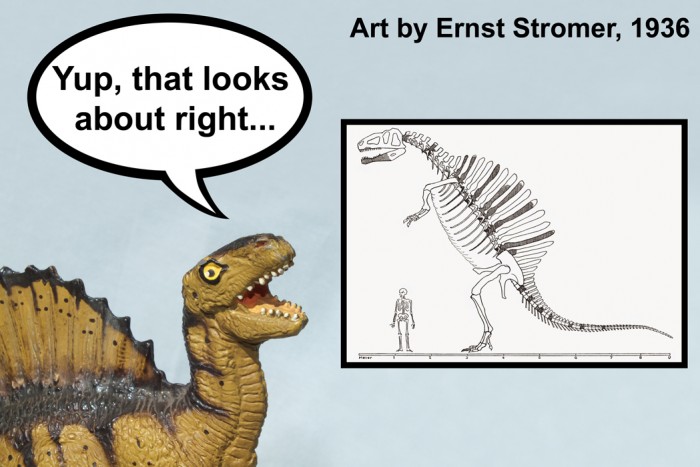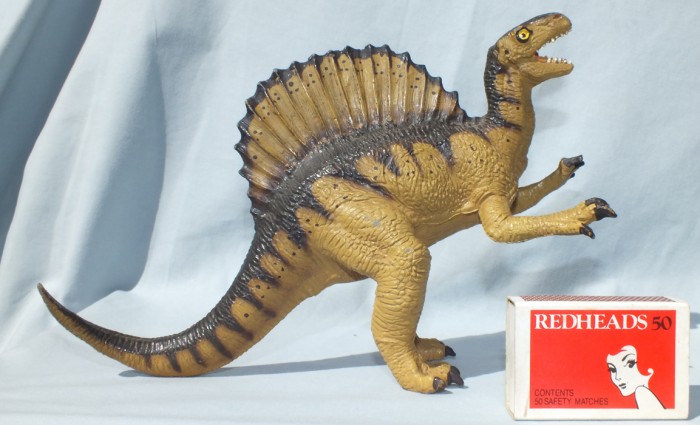For today’s review, we are going to travel back in time, to such an unimaginably distant era that the world as we know today it simply didn’t exist… specifically, the year 1992. For lovers of carnivorous dinosaurs, this was a simpler and more innocent time. Tyrannosaurus rex ruled with comfortable certainty as the biggest and baddest of them all; Archaeopteryx was the only dinosaur with feathers; a certain movie that was to forever confuse Deinonychus with Velociraptor in the popular imagination was still a year away from release; and we imagined that a relatively obscure carnivorous dinosaur called Spinosaurus looked something like this…
Today I am reviewing the original 1992 version of the Carnegie Collection Spinosaurus, which was in production until 1996. In order to fairly evaluate this model, it first necessary to understand our changing perceptions of the animal itself, so in the interests of being vaguely educational, here is a brief history (readers who already know this stuff may choose to skip ahead). Spinosaurus has quite a venerable pedigree among dinosaur fossils, being first described by the German palaeontologist Ernst Stromer in 1915. But sadly, these original fossils were destroyed in 1944 when their Munich museum was hit by an Allied bombing raid, a poignant reminder (for dinosaur-lovers at least) of the awful tragedy of war. In 1936, Stromer published an influential skeletal reconstruction of Spinosaurus, basically depicting it as a “typical” Allosaurus-like carnivorous dinosaur made remarkable by the sail of skin supported by the extended vertebrae along its back. This was to be the template for the way the animal was reconstructed for decades after. So if, like me, you grew up poring over dinosaur books during the nineteen-eighties, this is how you were accustomed to view Spinosaurus, and this is exactly what the 1992 Carnegie sculpt delivers – a generic-looking carnivore of moderate size, with a kangaroo-like posture, a rex-like head, and sporting a really, really cool-looking sail.
As I recall, Spinosaurus was a pretty obscure dinosaur back then – everyone in the schoolyard knew Rex and Triceratops, but to know Spinosaurus you had to be sufficiently into dinosaurs to seriously diminish your social standing. The transformation of Spinosaurus began with the description of the related Baryonyx in 1986, which clarified that the skulls of these theropods were long, flat and tapering, superficially resembling a crocodile’s jaws in profile, and filled with conical teeth strongly suggesting these animals made their living by catching fish. Here at last were a group of large theropods that didn’t just look like scaled-down versions of T. rex! In the late nineties, new partial skeletons of Spinosaurus found their way to museums, and a new image of this animal as a gargantuan yet surprisingly-graceful crocodile-headed predator began to emerge. It was now clear that Spinosaurus rivalled Tyrannosaurus in size; it was certainly longer, at around 15 as opposed to 12 metres, but was probably more lightly built. For better or for worse, this “new” image of Spinosaurus was taken up by the 2001 film Jurassic Park III, which has defined the look of Spinosaurus in popular culture ever since.
Spinosaurus as the Jurassic Park monster was enthusiastically embraced by Papo in 2009, while the Carnegie collection issued a “new and improved”, scientifically informed Spinosaurus in the same year. In their own way, both these models are far superior to 1992 Carnegie reviewed here, a model that has clearly been left behind by the march of scientific progress. As we have seen, we now know the skull is completely wrong for a Spinosaur, and the arms are conspicuously pronated. Another thing about this model I always found odd is the size. At the constant 1:40 scale Carnegie used to stick to in the good old days, a 15m Spinosaurus should be about 38cm long. This model is only around 27cm (along the spine), resulting in a scale closer to 1:55 (perhaps it is a juvenile?). Stromer’s archetypical 1936 restoration is accompanied by a scale bar indicating a length along the spine of at least 14 metres, so we have known this was a truly massive theropod right from the beginning.
In an ironic twist, the 2009 Spinosaurus by Papo and Carnegie are now themselves both dramatically out-of-date. In 2014, to considerable media interest, palaeontologists Nizar Ibrahim, Paul Sereno and colleagues published a new reconstruction of Spinosaurus as a truly semi-aquatic dinosaur that spent most of its time swimming. Their work had some very clever science, such as the observation that the bone density of Spinosaurus was more similar to aquatic animals like penguins than other predatory dinosaurs. More controversially, they argue that the hind limbs were much shorter relative to the forelimbs than has been traditionally reconstructed, making Spinosaurus an excellent dog-paddler but an obligate quadruped (animal that can only go on four legs) on land. All of this this results in an animal that would have looked and behaved radically differently from the Spinosaurus that Stromer first envisioned, and that inspired the 1992 Carnegie sculpt. To be fair, doubts have been expressed in some quarters that the quadrapedal Spinosaurus is based on an accurate skeleton, and like all dinosaur restorations, the paddling Spinosaurus is a hypotheses, or evolving idea, rather than established fact – hopefully new bones will further clarify the issue. I’m sure that many of us have been struck by the fact that a giant sail that would tend to catch the wind and blow the animal off-course seems a very odd feature to be possessed by a paddling animal trying to stalk fish. Clearly, Spinosaurus has not given up all its secrets yet.
Although the 1992 Carnegie Spinosaurus is now one of the least-accurate models in my collection, it is also one of my favourites! The pose is extremely dynamic and full of life, and the much maligned “tripod” posture of Carnegie bipeds actually works well here… The animal is depicted rearing up aggressively, bracing back on the tail (anatomically improbable no doubt, but it sure looks cool) and something about the posture of the arms suggests that an instant later they are about to lash out and inflict some serious damage with those massive claws. The sail is thinner than in many modern reconstructions (which favour a “fatter” sail based on the broad diameter of the vertebral spines) but from a purely aesthetic standpoint, the thin, Dimetrodon-like sail on this guy looks great and adds a lot of visual impact. But the best thing of all about this model is the colour scheme – a really striking “desert camouflage” of dark brown and ochre. The complex pattern of stripes, bands and dots creates something rarely achieved in dinosaur models – a colour scheme that is both visually arresting, and yet at the same time understated enough to seem eminently plausible as a reconstruction of a large reptilian predator. I think it’s one of the best colour schemes for a dinosaur toy that I’ve come across.
This version of the Carnegie Spinosaurus ceased production in 1996, but was immediately replaced by what appears to be the same figure in a different colour scheme. For purposes of comparison, I have illustrated this below, with a picture from Safari’s own catalogue. Purely from the photograph, I don’t feel that the newer colour scheme is as good as the version it replaced, but since I haven’t actually seen this second figure in person, I can’t fairly review it.
This at last brings me to my real reason for writing this review, which is to bid a fond and nostalgic farewell to the Carnegie Collection line of dinosaur figures. By now many dinosaur collectors will have heard that, as of March 2015, the twenty-eight year collaboration between the Carnegie museum and Safari toys has come to an end, and the figures will no longer be manufactured. So if you want to buy some Carnegie figures new, now’s the time, as the existing retail stock will not be replaced (panicky types might well use this as self-justification to go on an expensive, online buying spree…. I know I did). Given the profound significance of the Carnegie collection to our hobby, I thought it only appropriate to spill a bit of ink on the dinosaur toy blog to mourn their passing. Today, when we enjoy such an abundance and diversity of dinosaur toy lines from several quality manufacturers, it’s easy to forget how huge the impact of the early Carnegie Collection figures was. I’m sure many of us have fond memories of the first time we ever walked into a museum gift shop and saw these beauties so temptingly arrayed on the shelf! The collection itself was only four years old when the 1992 Spinosaurus was launched, and it was the first dinosaur figure I ever brought as an adult. All through my undergraduate years, it stood beside my computer, obligingly holding spare pens and pencils in its commodious arms, and I can confirm after much time-wasting… err, practical experiment that it is still unequalled in this role among dinosaur toys today.
While the Invicta models of the British museum justly deserve credit for being the very first accurate, museum-authenticated dinosaur toys, their monochromatic, unpainted plastic and relatively smooth textures made them more of an attractive statuette then a vividly life-like model. It was the Carnegie collection that really began the idea that dinosaur toys could be exquisitely textured and beautifully painted replicas of dynamic living animals, rather than perpetually snarling and freakishly inaccurate “prehistoric monsters”. Much is made of the “dinosaur renaissance” that transformed our perception of these animals from the 1970’s onward, and in its own way the Carnegie Collection made a real contribution to this, especially in terms of educating children. Regardless of your opinion of individual Carnegie sculpts (many would argue, for instance, that they never succeeded in producing a truly breathtaking rex) our hobby really wouldn’t exist without the market that Carnegie almost single-handedly created, and for that we are in their debt. Their legacy – the idea that children’s dinosaur toys could also be accurate and beautiful replicas – will live on for all of us who have ever picked up a brightly coloured plastic toy and imagined in our minds eye that true embodiment of childhood wonder, the dream of a living dinosaur.
Available from Amazon.com here.
Support the Dinosaur Toy Blog by making dino-purchases through these links to Ebay and Amazon. Disclaimer: links to Ebay.com and Amazon.com on the Dinosaur Toy Blog are often affiliate links, when you make purchases through these links we may make a commission








I actually when I was kid had a Spinosoures toy that was posed exactly like the Ernst Stromer rendition of it. This is the closest toy I have found to the one I had as a kid not that long ago.
Ever since I read Michael Crichton’s Lost World, I’ve always thought of this particular figure. There’s a chapter where Malcolm’s evaluating an animatronic dinosaur and criticizing it for looking like it should be holding a book and singing Christmas carols, and I reckon if you found a scaled-to book and put in in this Spinosaur’s hands it would be a perfect stand-in for Malcolm’s dopey velociraptor.
Great review. This was my first Carnegie dinosaur, I bought it back in 1992 when it was first released. I was only 6 then. I remember playing a lot with it even when I bought better models later. Fantastic toy/model. It ate many of my gi joes 😀